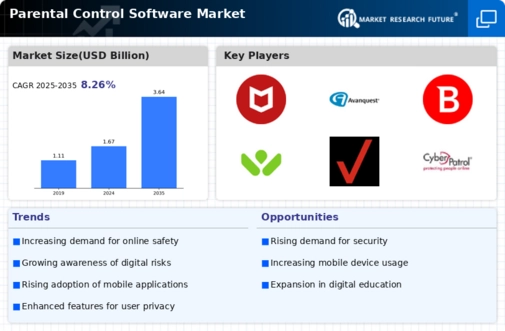Market Share
Parental Control Software Market Share Analysis
The surge in globalization has spurred technological advancements across various domains, including devices, software, and hardware. This progress has given rise to an interconnected world where devices such as smartphones, TVs, and laptops can seamlessly share data. The advent of the Internet of Things (IoT) has significantly amplified data sharing capabilities in this interconnected environment. This increased connectivity, particularly in the realm of parental control software, has ushered in a new era of enhanced content monitoring, providing parents with tools to ensure a safer online experience for their children. The integration of connected devices with parental control software marks a notable development in content monitoring. Parents now have the ability to set security parameters and filter content accessible to their children on various devices. This includes the power to monitor their children's activities whenever they engage with their devices, offering a proactive approach to safeguarding their online experiences. According to the GSM Association, the number of IoT-connected devices in 2017 stood at 7.5 billion, and this figure is projected to soar to 25.1 billion by 2025. The escalating utilization of IoT technology intensifies the interconnectivity between different devices, simultaneously raising concerns about the potential risks young individuals face when exposed to unwanted online activities. These risks may include harassment, embarrassment, or even situations leading to severe consequences like suicide. The challenge for parents lies in their ability to track and monitor their children's activities effectively, especially in an environment characterized by increased interconnectivity. To address these concerns, monitoring the content accessed or searched on various devices, such as mobile phones, tablets, computers, and smart TVs, has become imperative. This monitoring can be achieved through smartphones and specialized software integrated with parental control tools. By utilizing these features, parents can actively oversee their children's online activities, enabling them to stay informed about the content their children are exposed to and take timely measures to ensure a safe and secure digital environment. as the global landscape becomes more interconnected, the proliferation of IoT-connected devices introduces both opportunities and challenges, particularly in the realm of child safety online. The integration of parental control software with IoT-connected devices presents a crucial step forward in empowering parents to actively participate in monitoring and regulating their children's online experiences. Through effective content monitoring, parents can play a proactive role in mitigating potential risks and fostering a secure digital space for their children in this era of technological connectivity.












Leave a Comment